POPULAR WESTERN BOOKS AND WESTERN WRITERS IN JAPAN
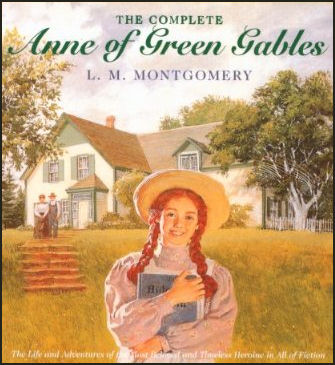
Highly-regarded Western books in Japan, according to a survey of Japanese critics and scholars on the best books of the 20th century, include “The Magic Mountain” by Thomas Mann, “Jean-Christophe” by Romain Rolland, “Remembrance of Things Past” by Marcel Proust, “One Hundred Years of Solitude” by Gabriel Marquez and “The General Theory of Employment, Interest and Money” by John Maynard Keynes.
Little Black Sambo is popular in Japan. Written by Helen Bannerman in Britain in the late 19th century, it is set in India and is about a boy who uses his wits to escape from a tiger. More than 1 million copies were sold between 1953 and the 1999. Publication as stopped for a while over criticism that it was racist but was published again beginning in 2005.
Japanese love “ The Dog of Flanders”, a story set in Belgium about a boy named Nelo who wants to be painter but is falsely accused of arson and is driven from his village. Accompanied by his dog Patrasche, Nelo endures snowstorms to makes his way to Antwerp where he sees a Ruben’s painting he saw in his dreams and then freezes to death. The book was written by British author Marie-Louis Rame under the pen name of Ouida, in the 1870s. It is little known in Europe where it tends to seen as story of the death of “a big loser.” In the United States it has had been made into movie five times, each time with a happy ending.
Explaining the popularity of the story in Japan, the producer of a Dog of Flanders film, An van Dienderen told the Yomiuri Shimbun, “The Japanese people, they think they reach a certain level of nobility by accepting defeat or failure in order to preserve things like loyally, friendship dedication. This is exactly what happened to Nelo and Patrsche. Their death exemplifies such values of the Japanese people.”
The Japanese version of the last Harry Potter novel went on sale in July 2008 with a first printing of 1.8 million copies.
Mario Vargas Llosa, the Peruvian writer and winner of the 2010 Nobel Prize in Literature, told the Yomiuri Shimbun the main character in his sole love story, “ The Bad Girl “, was based on a Japanese woman . The mysterious, identity-changing protagonist is one of his most famous characters.
Kodansha International, the English-language imprint of Japanese publishing giant Kodansha Ltd., closed in April after 48 years--a move that was apparently unexpected by the imprint's authors and, by some accounts, its own staff and editors. Kodansha International translated and published numerous works of Japanese literature and nonfiction, including elaborately illustrated guides to Japanese robots, baths and sake. It was also a crucial purveyor of books delineating Japanese popular culture to non-Japanese fans, scholars and general readers. [Source: Roland Kelts, Daily Yomiuri, June 10, 2011]
Good Websites and Sources: Anne of Green Gables and Japan /mediacentre.canada.travel ; Lafcadio Hearn trussel.com ; JNTO article Hearn’s Town of Matsue JNTO
Links in this Website: JAPANESE CULTURE Factsanddetails.com/Japan ; JAPANESE CULTURE AND HISTORY Factsanddetails.com/Japan ; CLASSIC JAPANESE LITERATURE Factsanddetails.com/Japan ; TALE OF GENJI Factsanddetails.com/Japan ; BASHO, HAIKU AND JAPANESE POETRY Factsanddetails.com/Japan ; CLASSIC 20TH CENTURY JAPANESE LITERATURE Factsanddetails.com/Japan ; MODERN LITERATURE AND BOOKS IN JAPAN Factsanddetails.com/Japan ; HARUKI MURAKAMI Factsanddetails.com/Japan ; POPULAR WESTERN BOOKS AND WESTERN WRITERS IN JAPAN Factsanddetails.com/Japan
Anne of Green Gables and Japan
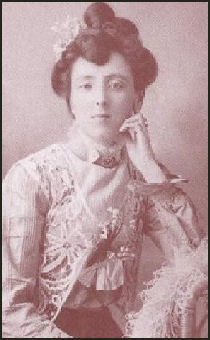
Montgomery The 1908 novel “Anne of Green Gables”, and other books in the Anne series, by Canadian writer Lucy Maud Montgomery, are extremely popular in Japan. Known to the Japanese as "Anne of Red Hair," she is so popular that she has spawned numerous Anne clubs that have names like the Buttercups and the Anne Clan. There are even schools that teach students how to act like Anne and speak English with an Anne accent.
“Anne of Green Gables” is about a spunky, independent-minded orphan girl who is adopted by an elderly brother and sister who are not married. Most of the Anne books revolve around various episodes that result from the clash between Anne's independent ways and the conservative, provincial, busy-body mentality of many of the people in her adopted town.
“Anne of Green Gables” was first published in Japan in 1952 and was an immediate bestseller, perhaps because there were so many orphans in Japan and the fact country needed lift and Anne’s spunkiness was uplifting. In the years that followed an Anne industry grew with books, manga, anime and films.
Most of Anne fans are single women in their late teens and early 20s, who admire Anne for her feminist spunk. Explaining why the book is so popular in Japan, a director of an Tokyo academy that teaches "Anne's principles" said, "Ladies in Japan have to follow many rules. You have to do this or that, you can't do this or that. It's very difficult to be free like Anne." Anne's loyalty to her family above all else is something that Japanese can relate to.
Anne of Green Gables and Japanese Tourists
A whole “Anne of Green Gables” travel industry has developed for Japanese on Canada's Prince Edward Island, where the stories take place. The stories are popular in other countries, but the Japanese are the only people who travel to Prince Edwards Island (at least a 20-hour plane trip from Tokyo) in large numbers and visit the Montgomery's home and various sights associated with the Anne books.
In addition to young single women there are also large number of salarymen and housewives who visit the Anne sights on Prince Edwards island. Around 50 Japanese couples each year get married in the room where Montgomery married her husband. In 2000, one of the newlyweds was a sumo wrestler who said it had always had been his dream to come to Prince Edward Island to get married.
Some Japanese women come with their hair died red. Some break into tears when they arrive and light up when every the see notebooks or hair from cats owned by the author. For those that can’t make the trip to Canada, some department stores in Japan attract customers with Anne memorabilia borrowed from Prince Edwards island.
'Little House' Series
The “Little House” series — both in book and TV form — as been popular over the years in Japan. Yukiko Furusawa wrote in the Yomiuri Shimbun: “Yumiko Taniguchi's fascination with Laura Ingalls Wilder's "Little House" series dates back to when she was 11. The young Taniguchi came across a book in the series in which the American author describes her childhood--her family moved to remote prairie and forest locations with no neighbors, built log cabins and produced their own food. It was about 15 years before the TV version of the series was aired and became popular in Japan. [Source: Yukiko Furusawa, Yomiuri Shimbun, July 28, 2012]
Taniguchi found Laura, who lived in America's vigorous pioneer days, to be "quite different from other heroines," the 63-year-old recalled. Taniguchi, who loved studying English, became a translator after graduating from university. In 2000, she took charge of new translations of the series' latter five books. "I'd like to share the fascination with these works with younger generations," the translator said.
Taniguchi has a photocopy of a letter that Wilder sent to Japanese fans and the Japanese translations of the series that were released soon after the end of World War II. Wilder started writing the autobiographical works in her 60s in the hopes of encouraging suffering Americans during the Great Depression, and eventually completed 10 books before her death at the age of 90. The "Little House" series describes how the author's family enjoyed a simple life while helping each other. "I believe the family's lifestyle can give inspiration to Japanese today," Taniguchi said.
Books About Japan
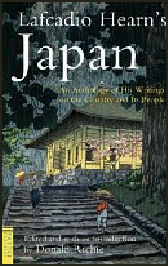
Books about Japan tend to highlight its traditions and strangeness and fail to adequately present it as a complex place made of complex human beings. Among the works that do a good job on getting beneath the surface of Japan are”The Road Through Miyama” by Leila Philip, about working with a Japanese potter in the countryside, and books about politics, history and foreign affairs by Ian Buruma, a professor at Bard College who is married to a Japanese woman.
The famous 19th century British writer and explorer Isabella Bird (1831-1901) traveled extensively in Japan and wrote “ Unbeaten Tracks: Japan “ about her experience.
David Mitchell, a novelist known for his bold, experimental novels like “ Ghostwritten “ and “ Cloud Atlas “, has produced intriguing works about modern Japan ( “number9-dream “) and old Japan (“ The Thousand Autumns of Jacob de Zoet “). The latter is set in 18th and 19th century Nagasaki and is centered around the dealings between the Dutch and Japanese at a time when Japan was suspicious and hostile towards Westerners and Christianity. Neil Mukherjee of the Times of London wrote the book “is executed on a vast canvas, every inch of which worked with exhilarating skill and precision...Not the least astonishing of Mitchell’s art is the supple effortlessness he brings to creating....world’s so credible and fully formed that one is compelled to allow it to pass through one’s mind the absurd thought that he was, perhaps, an inhabitant of Japan in 1799.”
Peter Tasker has written several novels set in Tokyo. His forth one, “Dragon Dance”, is set in 2006 as the Japanese economy is collapsing. His books are often released in Japan in Japanese before they come out in English, the language they were written in.
“Across the Nightingale Floor” (2002); “Grass for His Pillow; Brilliance of the Moon: The Harsh Cry of the Heron” and “Heaven’s Net Is Wide” is a series by Lian Hearn about a brutal clan, the Otari, and their adventures in feudal Japan. Lain Hearn is a pseudonym for Gillian Rubinstein, a British-born Australian The books describe stonemasons sealed alive in the parapets of their bridge to appease water kami; persecuted Christian hung upside down over fire and slowly burned to death head first; and a samurai “amazed how easily the blade slid through clothing and flesh, how it whipped back and cut again, this time into the top of the neck.”
Lafcadio Hearn
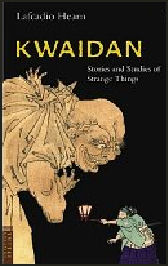
Lafcadio Hearn (1850-1904) was an eccentric, Greek-born, Irish-American who married the daughter of a samurai, became a Japanese citizen, and adopted the name Yakumo Koizumi. Educated in France and Britain, he fell in love with Japanese culture and country life and collected Asian ghost stories and folk tales. Blinded in one eye in a childhood accident, he enjoyed reading so much it was said it his good eye sometimes bulge out of his head, twice it's size.
Born in 1850 to a Greek mother and Irish father, Lafcadio was educated in Dublin and later England, then sent to America at the age of 19. Kevin Short wrote in the Daily Yomiuri: Blessed with a vivid imagination, a fascination with the macabre and mystical, and substantial literary skills, he quickly landed jobs as a newspaper and magazine writer. Lafcadio's writing assignments took him from Cincinnati to New Orleans and on to the Caribbean islands. In 1890, Harper's Magazine sent him to Japan to research and write a series of travel essays. Living first in Tokyo but then moving on to Matsue along the Sea of Japan in Shimane Prefecture, he quickly developed a deep aesthetic, sensual and spiritual connection to the Japanese land and people. [Source: Kevin Short, Daily Yomiuri, July 27, 2012]
The turn of the century was a time when Japan was rapidly modernizing, and old customs and lifestyles were considered backwards or superstitious. Lafcadio's many fine books and essays not only introduced Japan's rich traditional culture and folklore to foreign audiences, but also helped foster a better sense of appreciation among the Japanese themselves. Lafcadio is most famous for his spine-tingling tales of ghosts and goblins. He also, however, was deeply interested in traditional Japanese ways of relating to nature, and collected a wealth of stories and beliefs associated with plants and animals.
Lafcadio married a woman from Matsue and remained in Japan until his death in 1904. He even took Japanese citizenship, changing his name to Yagumo Koizumi--Koizumi being his wife's maiden name and Yagumo an old poetic term for the Matsue region that he loved so dearly. Hearns taught at a local school, collected birds and insects in cages in his house and smoked a pipe. He kept a conch shell which he reportedly used to call servants to light his pipe. Hearns never mastered the Japanese language but that didn’t stop him from writing 10 landmark books on Japan while he lived there from 1894 to his death in 1904. He wrote “Kwaidan” (1904) and other collections of ghost stories (See Film). His vivid descriptions in “Glimpses of Unfamiliar Japan” helped introduce Japan to the West.
In his book on ghosts Hearn wrote about a stone turtle at Gesshoji temple in Matsue that comes to life at night and devours people and a female ghost at Daioji temple in the same town that gave birth to a baby in a grave and then went out to buy candy for the child. Hearns’s later works are more precise and restrained than his flowery early works. In “The Chief City of the Province of Gods”, for example, he wrote the early morning noises in Matsue begin with the “pounding of the ponderous pestle of the “kometsuki”, the cleaner of rice — a sort of colossal wooden mallet...Then the boom of the great bell of Zokoji the Zenshu temples is heard followed by “the melancholy echoes of drumming...signaling the Buddhist hour of morning prayer.”
See Ghost Stories
Donald Keene
Donald Keene is a prominent scholar of Japanese literature at Columbia University. His many books on Japan include “ The Pleasures of Japanese Literature “ (1988) and “ Emperor of Japan: Meiji and His World, 1852-1912 “ (2002). He has also translated the works of some of Japan's best-known authors, including Yukio Mishima, Kobo Abe and Yasunari Kawabata. Keene was friends with Mishima and is rumored to have been his lover.
Keene was born in New York in 1922. He attended Columbia University, where he became fascinated with Japanese culture after reading an English translation of “ The Tale of Genji. “ He later served as an interpreter during the Battle of Okinawa in the closing days of the Pacific War. "When I returned to Tokyo eight years after World War II, Japan had revived to become a far different country from what I'd seen just after the war's end." he said. In the 1950s, Keene studied at the postgraduate school of Kyoto University. Beginning there he forged friendships with such literary giants as Yukio Mishima, Junichiro Tanizaki and Kobo Abe.
In 2008, Keene was given the Order of Culture by the Japanese government in recognition of his contributions to promoting Japanese literature and culture in Europe and the United States.
Donald Keene’s Studies of Japan
Keene has traveled through the tsunami-hit Tohoku region many times, including some research trips for "The Narrow Road to Oku," his English translation of the classic work of literature "Oku no Hosomichi," by haiku master Matsuo Basho (1644-1694). While studying in Japan, "I was surrounded by many people who warmly extended a helping hand to me," Keene said.
Referring to his first encounter with noh performance while he was studying in Japan, Keene told his students: "You have to sit on your legs, Japanese style. After a couple of hours, my legs were completely paralyzed. The next problem was that there was no food. Memories of my first noh experience involve feeling great pain.” He then added, "I have come to love noh.”
Donald Keene Decides to Move to Japan
In April 2011, Keene said he decided to move permanently to Japan. A short time later he delivered his final lecture at Columbia. By that time the 88-year-old professor emeritus had started the process of acquiring Japanese citizenship, friends said. While he has been spending half of each year in Japan for some time, he determined around January to live in the country full time, partly because travel had become physically demanding for him. He now lives in Kita Ward, Tokyo, where he has owned a home since the 1970s.
Keene said the March 11, 2001 earthquake had distressed him and intensified his desire to make Japan his home. "Japan will surely resurrect itself from the disaster to become an even more splendid country than before, I believe," he said before leaving. "So I'll be moving to Japan in a positive frame of mind."
By obtaining Japanese citizenship, "I'd like to convey my sense of gratitude to the Japanese people, which I've so far been unable to do," Keene said. Referring to reactions in the United States to the earthquake, tsunami and aftermath, including the nuclear crisis, Keene said, "Not a few people in the United States have been moved to learn Japanese people are doing their utmost to rebuild." [Source: Michinobu Yanagisawa, Yomiuri Shimbun, April 24, 2011]
Keene stressed that living in Japan would bring the most meaning to the rest of his life. He plans to spend time writing biographies of Hiraga Gennai (1728-1780), a scholar of Western studies in the Edo period (1603-1868), and Takuboku Ishikawa (1886-1912), a poet in the Meiji era (1868-1912).
Donald Keene Becomes Japanese Citizen
In March 2012 Keene was granted Japanese citizenship, the Justice Ministry announced in a government gazette. He expressed his intention to obtain Japanese citizenship after the March 2011 earthquake and tsunami. "I love Japan," Keene said, while explaining his decision to move to Japan at a press conference following his last lecture at Columbia University. He now lives in Tokyo. [Source: Yomiuri Shimbun, March 9, 2011]
Keene expressed his joy over the news that he has been granted the Japanese citizenship in an interview with The Yomiuri Shimbun at his home in Tokyo. "I'm so glad to finally be able to become Japanese," a smiling Keene said. "If my decision encourages the Japanese people, it's a great joy."
Right after the March 2011 disaster, Keene saw the stoic suffering of people in the Tohoku region on TV. Worried over the news that an increasing number of foreigners were leaving the country, keene made up his mind to permanently live in Japan. "I wanted to endure the hardships with the Japanese, who had taken good care of me, at a difficult time like this," he said.
Keene wondered how long it would take to obtain citizenship, but officials only told him it would take some time. He sometimes expressed his anxiety to people around him, saying, "As I'm already 89 years old, I don't have much time left." In the end, he obtained his citizenship in only about four months. "Donald Keene" became his pen name, and his Japanese name is now Kiin Donarudo.
Donald Richie
An essay written by Donald Richie that appeared in his 1987 book “ Different People: Pictures of Some Japanese “ begins with his recollection of seeing a woman narrowly miss catching a train. Richie notes the prevalence of "disappointed grinners" in Japan. Richie suggests that smiling in the face of thwarted wishes expresses a basic attitude in which personal preference is set aside for an "appreciation of reality" that is quite different from the American outlook regarding similar setbacks.”
Donald Richie is arguably the most insightful writer on Japan. His books “The Inland Sea” and “Geisha, Gangster, Neighbor, Nun” are regarded as a groundbreaking works that portray a side of Japan that has been missing from the stereotypes about the country. Richie is interested most in culture, particularly film and literature, and sex. He befriended Kurosawa and other famous Japanese and entertained American celebrities such as Truman Capote and Francis Ford Coppola when they came to Japan. “The Japan Journals: 1947-2004" recalls some of Richie's more memorable moments. He is not to be confused with Donald Keene, the distinguished professor and Japan literature expert at Columbia University.
James Bond and Ian Fleming in Japan
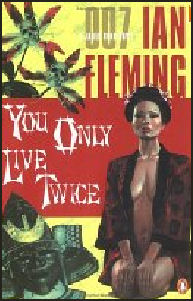
The James Bond novel “You Only Live Twice” was set in Japan. In the book Bond goes on a sake bender, consuming 35 cups of the drink, more than he consumed of any other drink in the whole Bond series. His record for vodka martinis, his signature drink, was 18. The film version of the novel was released in 1967 and earned more than $100 million at the box office, a phenomenal sum at that time. It featured sumo wrestling, sexy Japanese girls and the line, “Welcome to Japan, Mr Bond.”
There were references t Japan in other books. In “From Russia with Love” Rosa Klebb tried to kill Bond with poison from a fugu fish. Oddjob, the Japanese villain who used his steel-rimmed derby like a decapitating frisbee, appeared in the 1964 James Bond film “Goldfinger”.
Ian Fleming, the author the James Bond series, first visted Japan in 1959, arriving from London after a week-long journey via Beruit, Bahrain, Delhi, Bangkok, Hong Kong and Macau. “With only three days in Japan,” he wrote. “I decided to be totally ruthless. No politicians, museums, imperial palaces or tea ceremonies...I wanted to see a Sumo wrestling match, explore Ginza, have the most luxurious bath, spend an evenings with geishas, take a day trip into the country, eat large quantities of raw fish, for which I have a weakness, and ascertain whether sake was truly alcoholic or not.”
Fleming arrived with lots of baggage, a typewriter and lots of prejudices. “I was full of reservations about Japan. Before and during the war they had been bad enemies and many of my friends had suffered at their hands.” Fleming’s guides were Richard Hughes, a hard-drinking Australian journalist and part time M-16, spy, and Japanese journalist Toreo “Tiger” Saito. In “You only Live Twice”, Hughes was the model for “Dikko” Henderson and Saito became the fictional Tiger Tanaka, head of the Japanese secret service.
James Clavell’s Shogun
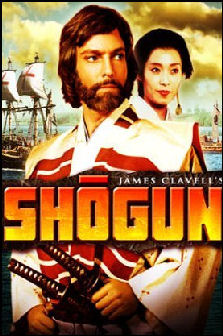 James Clavell wrote “Shogun” and his last book “Gaijin” about Japan.” Shogun “ is set in the early Edo Period (1603-1867) when Tokugawa Ieyasu became shogun in 1603 after a victory at Sekigahara in 1600. The story that takes place in 1614, when the fortress of Osaka was captured and the last rival warlords were pacified.
James Clavell wrote “Shogun” and his last book “Gaijin” about Japan.” Shogun “ is set in the early Edo Period (1603-1867) when Tokugawa Ieyasu became shogun in 1603 after a victory at Sekigahara in 1600. The story that takes place in 1614, when the fortress of Osaka was captured and the last rival warlords were pacified.
The “Shogun” story is based on the adventures of William Adams, an English ship pilot who lived in Japan from 1600 to 1620 and befriended Ieyasu. Adams arrived in Japan on a Dutch ship. He was imprisoned after his arrival on the bequest of a Portuguese priest and was released and invited to visit the shogun’s court in Osaka. As an advisor to Ieyasu, Adams gave the Japanese advise on making Western-style ships and served as a diplomat in sort of the same way that Marco Polo did for Kublai Khan. For his efforts Adams was rewarded with the title of samurai and given an estate on Miura peninsula and was granted permission to open a trading post for the English. Adam’s status and influence was luck ran out when out Ieyasu died. Adam’s story is told in the book “Samurai William: The Englishman Who Opened Japan” by Giles Milton.
Adams was the model for the character John Blackthorne in “Shogun”. He married a local beauty (ignoring the fact he had a wife in England) and was granted a fiefdom close to Edo. He never returned to England and died in Japan in 1620.
Memoirs of a Geisha
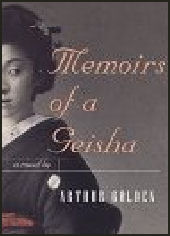
U.S. cover “Memoirs of a Geisha” is an entertaining and wonderfully written page-turner written by Arthur Golden. The book is about a young girl from a poor fishing village who sold into the geisha world and overcomes a geisha rival to become one of the top geishas in 1930s Japan. Golden has an eye for detail and the book does a fairly good of of conjuring up images of the geisha world in Japan of the 1920s and 30s.
”Memoirs of a Geisha” was a huge success. It was on the New York Times bestseller list for 58 weeks and sold more than 4 million copies in English and has been translated to 32 languages. It inspired a fascination in anything having to do with geishas. Models at fashion shows in Paris and Milan showed kimonos and obis after the book came out and tourists came to Japan looking for geishas.
Source of Memoirs of a Geisha
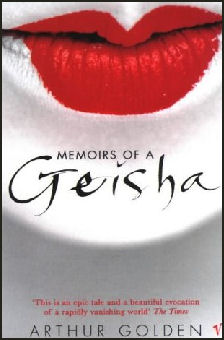
U.K. cover Much of material on geishas of “Memoirs of a Geisha” came from long interviews Golden conducted with Mineko Isawaki, a Kyoto geisha who was recruited at the age of 5 and worked in Gion for 23 years before retiring in 1980 to raise a family.
Isawaki was one of Kyoto's top geisha. She invited Golden to stay at her house for two weeks in 1992 and during that time described the intimate details of her profession. "I asked Mineko every question on my mind, a number of them about sex," Golden told Newsweek, "and she answered every one with candor. Even her husband was very nice. He bragged about the [sale of her virginity]. She'd set a record." Her virginity sold for about $850,000.
Isawaki later sued Golden for breach of contract and breaking an agreement to keep her identity secret. She asked for an "appropriate percentage" of the millions Golden earned from the book. A spokesmen for Golden's publisher said the allegations were "totally without merit." Most geisha don’t care about the book. They say much more unflattering and controversial books have been written by Japanese.
Image Sources: Amazon.com
Text Sources: New York Times, Washington Post, Los Angeles Times, Daily Yomiuri, Times of London, Japan National Tourist Organization (JNTO), National Geographic, The New Yorker, Time, Newsweek, Reuters, AP, Lonely Planet Guides, Compton’s Encyclopedia and various books and other publications.
Last updated January 2013
